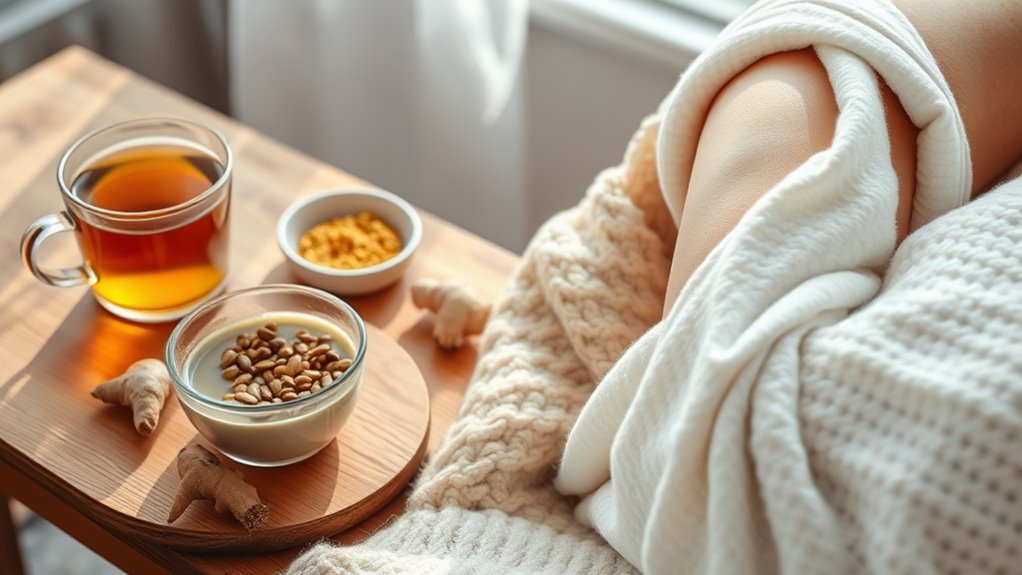Quick Home Remedies That Soothe Knee Pain Instantly
Imagine a sharp twinge in your knee that makes every step feel like a challenge. It’s frustrating, but you don’t have to let knee pain control your life. There are quick home remedies that can provide instant relief and help you regain your mobility. From ice therapy to essential oils, these solutions can be easily incorporated into your routine. Let’s explore effective strategies to soothe that discomfort and enhance your quality of life.
Key Takeaways
- Apply an ice pack wrapped in cloth to the knee for 15-20 minutes to reduce inflammation and numb pain.
- Elevate the knee above heart level using pillows to encourage fluid drainage and minimize swelling.
- Incorporate natural anti-inflammatory foods like salmon, leafy greens, and berries into your diet to help alleviate pain.
- Use essential oils like peppermint and lavender, diluted in a carrier oil, for topical massage to relieve pain and inflammation.
- Engage in gentle exercises like leg raises or stretching to enhance mobility and reduce discomfort in the knee.
Ice Therapy for Immediate Relief
When knee pain strikes, ice therapy can provide quick relief.
Applying an ice pack to your knee reduces inflammation and numbs the area, easing discomfort.
Just wrap ice in a cloth and place it on your knee for 15-20 minutes.
You can repeat this several times a day, especially after activities that aggravate the pain.
This method is one of the most effective knee pain quick remedies.
Remember not to apply ice directly to your skin to avoid frostbite.
With consistent use, you’ll notice a significant decrease in swelling and pain, helping you regain mobility and comfort. Additionally, ice baths can enhance blood flow and speed up recovery from discomfort in nearby areas.
Elevation Techniques to Reduce Swelling
After using ice therapy to manage immediate pain, elevating your knee can further help reduce swelling.
To do this effectively, lie down and prop your knee above heart level using pillows or cushions.
This position encourages fluid drainage from the knee joint, minimizing inflammation.
Keep your leg elevated for at least 20 minutes every couple of hours, especially during the first 48 hours after an injury.
Make sure you’re comfortable; avoid putting too much pressure on the knee.
Combining elevation with ice therapy maximizes your efforts in reducing swelling and promoting faster recovery. Additionally, consider using natural compression methods like elastic bandages to provide support while your knee is elevated.
Natural Anti-Inflammatory Foods
Incorporating natural anti-inflammatory foods into your diet can significantly help manage knee pain and promote healing.
Foods rich in omega-3 fatty acids, like salmon and walnuts, can reduce inflammation. Leafy greens, such as spinach and kale, provide essential vitamins and minerals. Berries, especially blueberries, contain antioxidants that combat inflammation. Spices like turmeric and ginger can also be powerful allies in your fight against knee pain. Don’t forget to include olive oil, which is known for its anti-inflammatory properties. Additionally, maintaining a healthy weight is essential for reducing strain on the knees and promoting overall joint health.
Essential Oils for Pain Relief
Have you ever considered using essential oils as a natural remedy for knee pain?
Essential oils like peppermint, eucalyptus, and lavender can provide effective pain relief thanks to their anti-inflammatory and analgesic properties. To use them, dilute a few drops in a carrier oil, such as coconut or olive oil, and gently massage the mixture into your knee. You can also add a few drops to a warm bath for a soothing soak. Inhaling the aromatic scents can further enhance relaxation. Remember to patch test before applying and consult a healthcare professional if you’re unsure about using essential oils. Additionally, using these oils can promote overall well-being, enhancing emotional and physical health.
Gentle Exercises to Enhance Mobility
Gentle exercises can significantly enhance mobility in your knees while promoting overall joint health.
Try simple movements like leg raises or seated marches to improve strength and flexibility. Stretching your hamstrings and quadriceps can also alleviate tension.
Remember to focus on low-impact activities, such as swimming or cycling, which are easier on your joints. Practicing yoga or tai chi can further enhance balance and coordination.
Aim for consistency, starting with 5-10 minutes daily and gradually increasing as you feel comfortable. Always listen to your body, and consult a healthcare professional if you experience pain during these exercises. Incorporating simple exercises into your routine can lead to significant improvements in knee health and quality of life.
